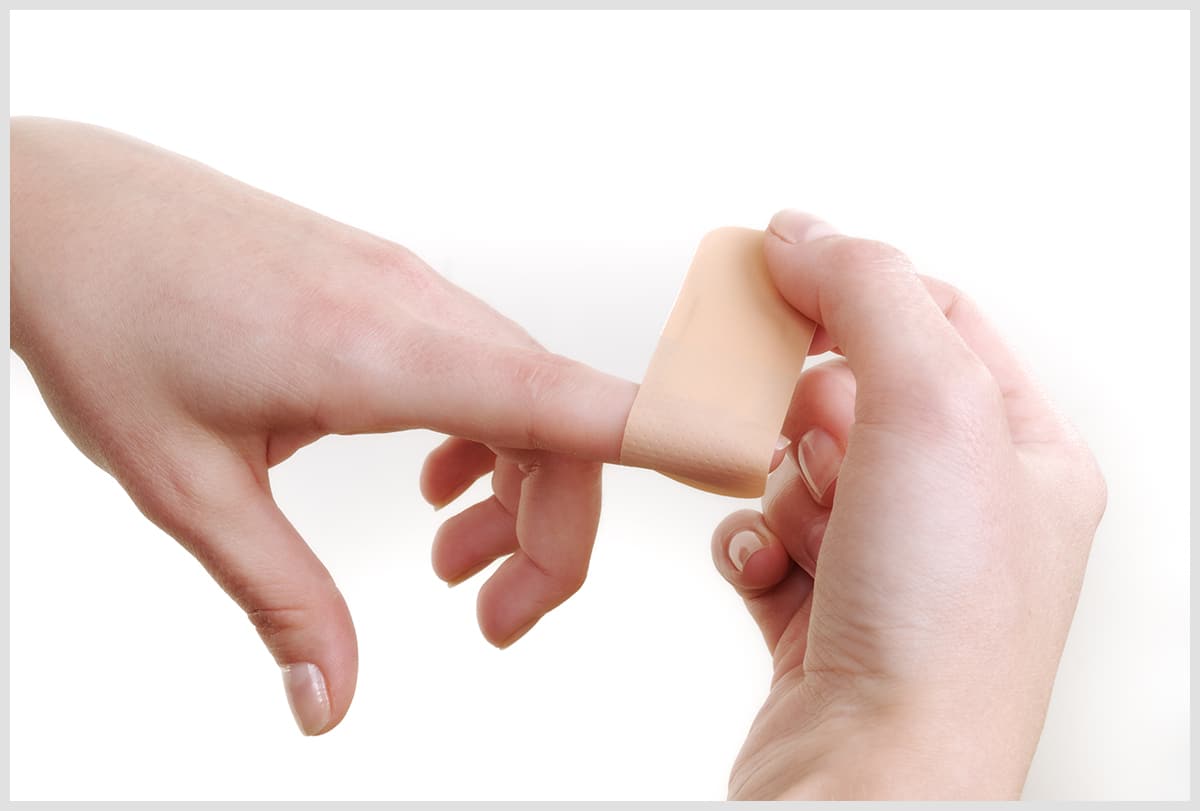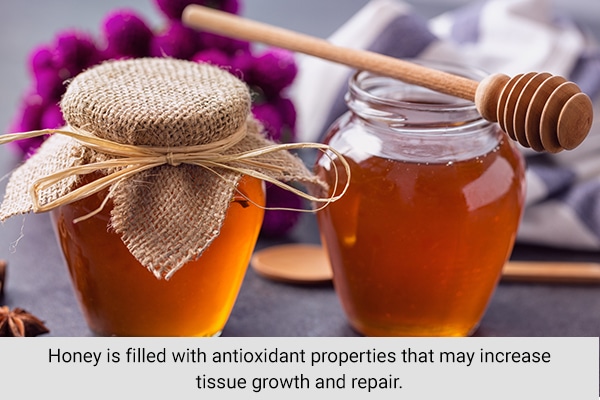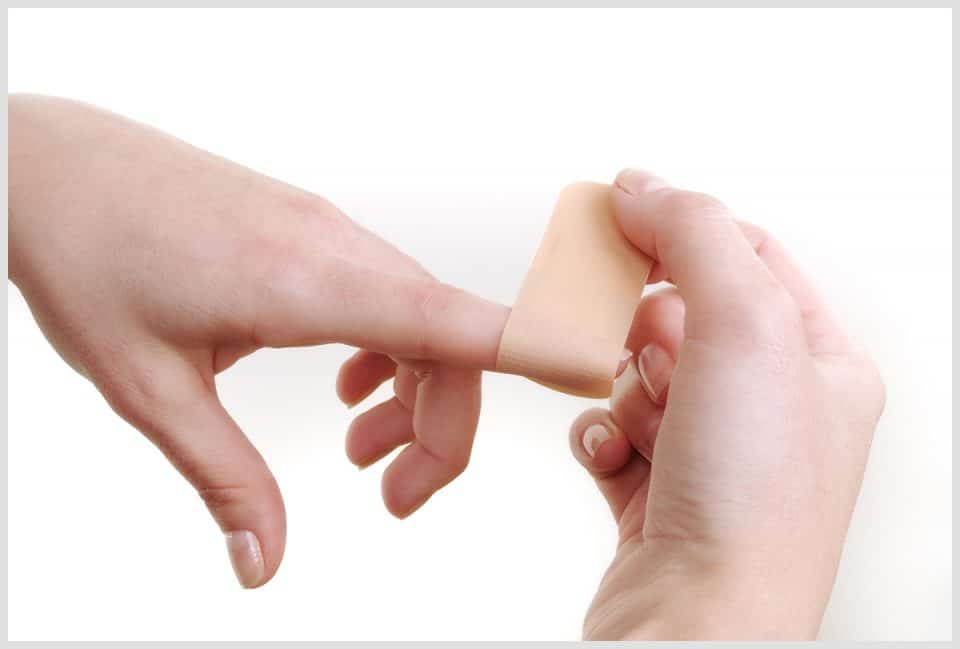Minor cuts or grazes are small wounds that may damage the skin surface. They may not be serious but are a pain to go through.

Grazes occur when the skin is damaged due to friction from tight-fitting clothes, falling hard, hitting a wall, etc. Cuts can either be small ones caused by a fruit knife, paper edge, etc., or a deeper one called a laceration. (1)
First Aid for Minor Cuts
Cuts are probably the most common form of minor injuries. They can happen to anyone from small children playing with a hazardous toy to adults using a knife in the kitchen.
Here’s what you can do when you get a cut:
- Do not touch the cut without washing your hands with soap and water.
- Wash the cut thoroughly with cool water to remove any dirt and soothe the pain.
- If the cut is bleeding, apply some pressure using a clean cloth or tissue until the bleeding stops completely.
- Use an antiseptic solution such as Povidone-iodine to clean the cut.
- Cover it with a Band-Aid.
Most cuts should heal within a week or two. However, if it takes longer than that or the wound seems swollen, pus-filled, etc., then consult a healthcare provider. (2)
Home Remedies for Minor Cuts and Grazes
Here are a few simple home remedies to help heal your cut faster:
1. Apply pure raw honey on the wound

Honey is filled with antioxidant properties that may increase tissue growth and repair. It also contains antimicrobial qualities that protect the wound from infections. (3)
You can apply honey directly to the wound to aid healing. You can also place some thyme leaves and honey in a mason jar, let it sit for a day or two, and then apply it to your wound.
2. Use chamomile tea bags
Chamomile has pain-relieving and antimicrobial properties. It helps heal the wound, soothe inflammation, and prevent infections. (4)
You can apply a cool wet chamomile tea bag to the wound. Press it on the area for a few minutes before removing.
3. Apply aloe vera gel on the wound
Aloe vera helps increase collagen production and prevents the growth of bacteria on the cut. It is a known anti-inflammatory agent and can provide quick relief from pain, burning, or irritation. (5)
Apply some fresh aloe vera gel to the wound. Let it sit for 20 minutes before washing it off. Repeat twice a day for best results.
4. Garlic application can help
Garlic contains antioxidant, anti-inflammatory, and antibacterial compounds. Allicin, an antimicrobial compound found in garlic, can help prevent wound infections. (6)
You can crush some garlic and mix it with honey to form a paste. Apply this mixture to the affected area. Wash it off after 10–15 minutes. Do not use it if it irritates your skin.
5. Try using tea tree oil
Tea tree oil is another excellent natural remedy for healing wounds. It can promote skin healing, reduce swelling, and prevent infections. It can be used for cuts, grazes, and scratches but not for burns. (7)
You can add a few drops of tea tree oil to a teaspoon of coconut oil and apply the mixture to the wound.
6. Using lavender essential oil can provide relief
Lavender essential oil is one of the most versatile oils. It is an effective disinfectant and pain-relieving agent. Its antioxidant properties also help promote the growth of new skin.
You can add a few drops of lavender oil to a teaspoon of coconut oil and apply the mixture to the wound. (8)
7. Apply echinacea ointment
Echinacea, or coneflowers, prevents wound infections and helps heal cuts faster.
You can use store-bought echinacea ointments to use on the wound. Alternatively, grind some echinacea flowers and mix the powder with honey to make your own ointment.
8. Use slippery elm bark
Slippery elm bark is filled with nutrients including antioxidants, vitamins, and minerals. It also has mucilage that can help soothe the wound and reduce pain.
You can grind some of this bark to make a powder and mix it with a little water. Apply the mixture to the wound using a clean cloth.
Self-Care for Wounds, Cuts, and Grazes
It is easy to look after most minor wounds and cuts yourself (provided you are not suffering from conditions such as diabetes or clotting disorders that can delay healing.)
Clean the wound every day using water and mild soap, change your Band-Aid every day, and watch out for signs of infections (pus, swelling, etc.).
Who Is Most at Risk?
These conditions increase your risk of wound infections or delayed healing:
Prognosis and Possible Complications
Most wounds tend to heal with no problem. However, some complications that can occur in wounds are:
- Infections
- Gangrene (tissue death)
- Sepsis
- Tetanus (a deadly infection)
How to Prevent Minor Wounds
Here are a few tips to prevent getting wounds:
- Wear well-fitting, comfortable shoes to prevent foot injuries.
- Be careful when cutting with knives in the kitchen.
- Use oven mitts when handling hot items.
How to know the wound is healing?
You will know a wound is healing when a small scab begins to form on it. This scab helps prevent dirt and bacterial growth on the wound.
When to See a Doctor
Contact a doctor immediately if:
- You got cut by an old or rusty object. You may require a tetanus shot.
- Your wound seems to be swollen or has pus accumulation. These are signs of infections.
- You have a wound that does not seem to be healing even after a few days or a week.
Final Word
Minor cuts and wounds tend to heal on their own in most healthy individuals. They do not require any medical evaluation and can be managed with home remedies and a first-aid box.
However, a wound that is not healing even after a week should be shown to a doctor immediately.

